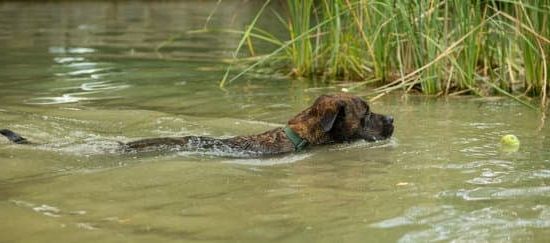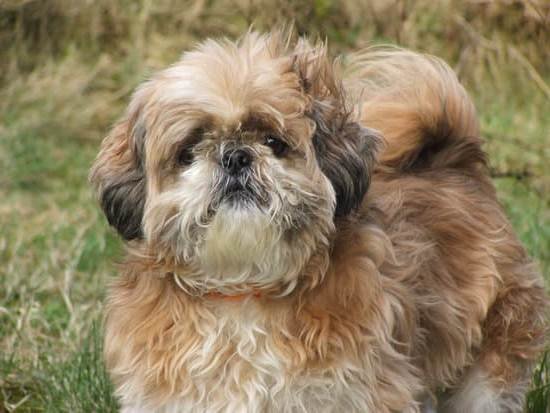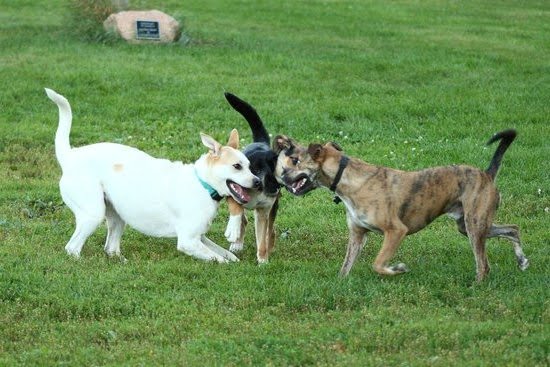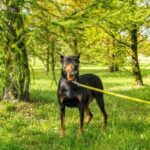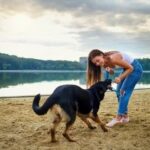Dogs are social creatures, but sometimes their interactions with other dogs can become problematic. Whether it’s barking, lunging, or aggressive behavior, reactive dogs can be difficult to handle and potentially pose a danger to themselves and others.
In this article, we will explore effective techniques and strategies for training a dog to not react to other dogs. By understanding the importance of this training and addressing the root causes of reactivity, you can ultimately create a calmer and more well-behaved canine companion.
Training a dog to not react to other dogs is essential for several reasons. First and foremost, it promotes safety for both your dog and those around them. Uncontrolled reactions can lead to fights and injuries, especially if another dog is reactive as well. Additionally, having an obedient dog that remains calm in the presence of other dogs makes walking or going out in public a much more enjoyable experience for both you and your pet.
To effectively train your dog to not react to other dogs, it is crucial to identify the triggers and behavior patterns that lead to reactive responses. Is it certain breeds or sizes that set off your dog? Does it happen when they feel threatened or restrained? Pinpointing these factors will help you address them directly during training sessions.
By following a comprehensive training plan that includes proper obedience training, controlled socialization experiences, desensitization techniques, positive reinforcement methods, distraction exercises, and seeking professional help when needed, you can make significant progress in reducing reactivity in your dog. With consistency and patience, you can celebrate your dog’s improved behavior and enjoy a fruitful journey together in overcoming their reactions towards other dogs.
The Root Causes of Reactivity in Dogs
Reactivity in dogs can manifest in various ways, such as barking, growling, lunging, or even aggression, when they encounter other dogs. To effectively train a dog to not react to other dogs, it is crucial to first understand the root causes of reactivity. By identifying triggers and behavior patterns, owners can tailor their training approach accordingly and address the underlying issues.
One common trigger for reactivity in dogs is fear or anxiety. Dogs may react aggressively towards other dogs as a way to protect themselves from perceived threats. This fear can stem from past traumatic experiences or lack of socialization during their critical development period. Understanding this fear-based reactivity allows owners to create a training plan focused on building confidence and positive associations with other dogs.
Another trigger for reactivity can be frustration or overexcitement. Some dogs become reactive when they are unable to approach or interact with other dogs due to leash restraints or barrier frustration. This pent-up energy leads to reactive behaviors out of frustration or excitement. Recognizing this trigger helps owners implement techniques like desensitization and counterconditioning to teach their dog more appropriate ways to handle these situations.
Observing behavior patterns is also essential in understanding reactivity triggers. Owners should pay attention to any specific cues that consistently precede the reactive behavior, such as body language changes or vocalizations from their dog. This awareness allows for early intervention and redirection before the reactivity escalates.
| Triggers | Behavior Patterns |
|---|---|
| Fear or anxiety | Barking, growling, lunging |
| Frustration or overexcitement | Leash restraints, barrier frustration |
Building a Strong Foundation
Establishing basic obedience training is an essential step in building a strong foundation for training a dog to not react to other dogs. This foundation provides a solid framework that allows your dog to understand and respond to commands, making it easier to manage their behavior and reactions in the presence of other dogs.
Basic obedience training includes teaching your dog fundamental commands such as “sit,” “stay,” “come,” and “leave it.” These commands are crucial for gaining control over your dog’s behavior and redirecting their attention away from potential triggers. Consistency is key when implementing basic obedience training, as dogs thrive on routine and repetition.
Positive reinforcement techniques are highly effective in basic obedience training. By using rewards such as treats, praise, or playtime whenever your dog successfully performs a command, you can create positive associations with obedience and motivate them to continue learning. It is important to remember that punishment-based methods can be counterproductive and may increase reactivity in some cases.
To track the progress of your dog’s basic obedience training, you can use a table to record their performance for each command. This will help you identify areas where more focus is needed and measure their improvement over time. The table should include columns for the name of the command, the number of successful repetitions, any errors made, and notes on areas that require additional practice.
By establishing a strong foundation through basic obedience training, you will provide your dog with the tools they need to succeed in overcoming reactivity towards other dogs. It sets the stage for further socialization techniques and allows you to effectively manage their behavior in various situations. Remember to be patient and consistent throughout this process, as building a strong foundation takes time and effort.
Socialization Techniques
Socialization plays a crucial role in training a dog to not react to other dogs. By introducing your dog to other dogs in controlled environments, you can help them become comfortable and confident around their canine counterparts. Here are some socialization techniques that can be effective in gradually acclimating your dog to interact positively with other dogs:
- Controlled Walks: Take your dog on regular walks in areas where you have control over the environment. Start by walking at a safe distance from other dogs and gradually decrease the distance as your dog shows more calm behavior. If your dog starts reacting negatively, increase the distance temporarily and resume the exercise when they have calmed down.
- Playdates: Arrange playdates with well-behaved and friendly dogs that are known to be calm and non-reactive themselves. Start with one-on-one interactions before gradually introducing more dogs into the playgroup over time. Ensure that the initial playdates take place in a familiar location for your dog, such as their own backyard or a neutral territory if necessary.
- Obedience Classes: Enrolling your dog in obedience classes can provide controlled environments for socialization. These classes often have structured activities that allow dogs to interact safely under the supervision of professional trainers. Through group exercises and controlled interactions, your dog will learn how to behave appropriately around other dogs while focusing on their obedience skills.
Remember, it is essential to closely monitor your dog’s body language during these socialization experiences – signs of fear or aggression should not be ignored. Always prioritize safety by maintaining control over the environment and keeping interactions positive and rewarding for your pet.
By utilizing these socialization techniques, you will help build a solid foundation for training your dog to not react negatively towards other dogs.
Desensitization and Counterconditioning
Dogs who react negatively to other dogs often have underlying fears or anxieties that contribute to their reactive behavior. Desensitization and counterconditioning are effective training techniques that can help reverse these negative associations and gradually change a dog’s emotional response towards other dogs.
Desensitization involves exposing the dog to controlled, low-intensity versions of the trigger situation in order to reduce their fear or anxiety response. This process is done gradually, starting at a distance where the dog feels comfortable and then slowly decreasing the distance over time.
For example, if your dog reacts negatively when seeing another dog from across the street, you might begin by practicing calm behaviors such as sitting or focusing on you while being far away from another dog. As your dog becomes more comfortable, you can gradually decrease the distance until they can remain calm even when passing by other dogs at close proximity.
Counterconditioning is a technique used to create positive associations with the trigger stimulus – in this case, other dogs. By pairing the presence of other dogs with things that your dog enjoys, such as treats or playtime, you can change their emotional response from fear or anxiety to excitement or happiness.
For instance, every time your dog sees another dog, you can reward them with treats or engage in a fun activity they love. Over time, your dog will start associating the presence of other dogs with rewards and begin to feel more positive emotions in their presence.
To implement desensitization and counterconditioning effectively, it is important to have a clear understanding of your dog’s threshold – the distance at which they start reacting negatively towards other dogs. It’s essential to work within this threshold and proceed at a pace that keeps your dog feeling safe and comfortable throughout the process.
Here are some steps for implementing desensitization and counterconditioning:
- Identify your dog’s threshold distance – the distance from other dogs where they start displaying reactive behavior.
- Create a positive association with the trigger stimulus by pairing their presence with treats, playtime, or other rewards that your dog loves.
- Gradually decrease the distance between your dog and other dogs over time, making sure to stay within their comfort zone and not pushing them too far too fast.
- Be patient and consistent with the training process, as desensitization and counterconditioning take time and repetition.
Remember, desensitization and counterconditioning are gradual processes that require patience and consistency. With proper implementation and positive reinforcement, you can help your dog develop more positive associations with other dogs and reduce their reactivity over time.
Positive Reinforcement Training Methods
Positive reinforcement training methods are an effective and humane approach to shaping desirable behavior in dogs. These methods focus on rewarding and encouraging your dog for exhibiting appropriate behaviors, rather than punishing or correcting them for undesirable reactions. By using positive reinforcement, you can help train your dog to not react to other dogs in a safe and supportive manner.
One of the key principles of positive reinforcement training is to reward your dog immediately after they exhibit the desired behavior. This helps them make a positive association between their actions and the reward, increasing the likelihood that they will repeat the behavior in the future. Rewards can include treats, praise, or playtime with their favorite toy.
In addition to rewarding your dog for calm behavior around other dogs, you can also use rewards as a way to distract them from reacting in a negative way. For example, if your dog starts showing signs of reactivity towards another dog on a walk, you can redirect their attention by offering them a treat or engaging them in a fun game.
This helps shift their focus away from the trigger and reinforces the idea that staying calm leads to pleasant experiences.
To effectively use rewards in training, it’s important to establish clear cues and signals that let your dog know when they are behaving correctly. For example, you can teach your dog a command such as “look” or “focus” that signals them to pay attention to you instead of reacting to other dogs. When your dog responds correctly to this command, promptly reward them with praise and treats.
By consistently using positive reinforcement training methods and providing regular rewards and encouragement, you can shape your dog’s behavior over time. Remember that each dog is unique and may respond differently to various rewards or forms of encouragement. Be patient with your furry friend as they are learning new behaviors, and celebrate each small step towards their improved ability to stay calm around other dogs.
Managing Reactivity
Reactivity in dogs can be a challenging behavior to manage, but with the right tools and strategies, it is possible to help your dog become more calm and controlled in situations involving other dogs. Here are some practical tips for managing reactivity:
- Walk on a Loose Leash: When walking your dog, it’s important to keep the leash loose to avoid creating tension and increasing their reactivity. Use a front-clip harness or head halter that provides better control and redirects their focus towards you.
- Create Distance: If you anticipate encountering other dogs during your walk, try to maintain a safe distance that doesn’t trigger your dog’s reactive behavior. Gradually decrease the distance over time as your dog becomes more comfortable.
- Use Visual Barriers: Utilize physical barriers such as trees or parked cars to temporarily block your dog’s line of sight when another dog approaches. This can prevent them from reacting impulsively and buy you time to redirect their attention.
- Reward Calm Behavior: Whenever your dog remains calm in the presence of other dogs, reward them immediately with treats or praise. This positive reinforcement helps establish positive associations with other dogs and encourages them to practice calm behavior.
- Seek Professional Help: If your dog’s reactivity is severe or if you’re struggling to make progress on your own, it may be beneficial to seek the assistance of a certified dog trainer or behaviorist. They can provide specialized guidance and develop a tailored training plan based on your dog’s specific needs.
| Tools | Strategies |
|---|---|
| Front-clip harness or head halter | Walk on a loose leash |
| Visual barriers (trees, parked cars) | Create distance |
| Treats or favorite toys | Reward calm behavior |
By implementing these tools and strategies, you can effectively manage your dog’s reactivity when encountering other dogs. It’s important to remain patient and consistent in your training efforts, as progress may take time. With dedication and the right approach, you can help your dog become more confident and comfortable in social situations, ultimately improving their overall quality of life.
Developing Distractions and Focus Exercises
In order to train your dog to not react to other dogs, it is crucial to develop distractions and focus exercises that will strengthen their ability to stay calm in the presence of other dogs. This section will provide you with some effective techniques and strategies for achieving this.
Introducing Controlled Distractions
One way to help your dog stay calm around other dogs is by gradually introducing controlled distractions during training sessions. Start by having a friend or family member bring their well-behaved and calm dog into the training area where you are working with your dog.
Keep a safe distance between the two dogs at first, and reward your dog with treats or praise for remaining calm and focused on you. As your dog becomes more comfortable, gradually decrease the distance between them while continuing to reward and reinforce their good behavior.
Focus Exercises
Focus exercises are an essential part of developing your dog’s ability to stay calm in the presence of other dogs. One effective exercise is teaching your dog to maintain eye contact with you on command. Begin by holding a treat close to your face and saying “look” or “focus.”
When they make eye contact with you, immediately reward them with the treat and praise. Repeat this exercise daily, gradually increasing the duration of eye contact required before giving the reward.
Another useful focus exercise involves teaching your dog a “leave it” command. This command will teach them to ignore distractions – including other dogs – when instructed to do so. Start by placing a few treats in one hand and keeping it closed.
Offer your closed fist to your dog, allowing them to sniff and lick it in an attempt to get the treats. As soon as they stop trying, say “leave it” and open your hand only when they divert their attention away from it. Reward them with a treat from another hand for leaving the closed fist alone.
Building Distance Thresholds
Another important aspect of developing distractions and focus exercises is building distance thresholds. This means determining the distance at which your dog starts to react to other dogs, but can still remain relatively calm and focused.
Begin by observing your dog’s body language and behavior when they are a safe distance away from another dog. Use this distance as a starting point for training and gradually decrease it over time as your dog becomes more comfortable and responsive to commands.
By implementing distraction and focus exercises into your training routine, you are helping your dog develop the skills necessary to remain calm in the presence of other dogs. Remember to be patient and consistent in your approach, rewarding desired behavior and gradually increasing difficulty as your dog progresses. With practice and perseverance, you will see improvements in their ability to stay calm and not react to other dogs.
Seeking Professional Help
Recognizing When Professional Help is Needed
At times, training a dog to not react to other dogs can be challenging and may require the expertise of a certified dog trainer or behaviorist. While many dog owners are able to successfully address their dog’s reactivity through self-guided training, there are situations where professional assistance becomes necessary. It is important to recognize the signs that indicate when seeking professional help is warranted.
One common signal that professional help may be needed is if your attempts at training have been consistently ineffective or have exacerbated your dog’s reactivity. If you find that despite your efforts, your dog continues to react aggressively or fearfully towards other dogs, it may be time to consult a professional. Additionally, if your dog’s reactivity poses a risk to their safety or the safety of others, it is crucial to seek guidance from an expert.
The Role of a Certified Dog Trainer or Behaviorist
A certified dog trainer or behaviorist can provide invaluable support and guidance in addressing your dog’s reactivity. These professionals possess specialized knowledge and skills that enable them to effectively assess and modify your dog’s behavior patterns. They will work closely with you and your dog to develop a customized training plan tailored to address the specific triggers and behavior issues exhibited by your pet.
Certified trainers and behaviorists employ evidence-based methods rooted in positive reinforcement techniques. They can identify underlying causes for your dog’s reactivity, whether it stems from fear, anxiety, territoriality, or other factors. By understanding the root causes of reactivity, they can design training exercises that focus on counterconditioning and desensitization to positively change how your dog responds in the presence of other dogs.
How to Find a Reliable Professional
When selecting a certified trainer or behaviorist for your reactive dog, it is important to do thorough research and choose someone who has experience working with reactive dogs specifically. Look for professionals who have a background in behavioral science and are certified by reputable organizations, such as the Certification Council for Professional Dog Trainers (CCPDT) or the International Association of Animal Behavior Consultants (IAABC).
Seek recommendations from other dog owners or your veterinarian, and schedule an initial consultation to discuss your concerns and goals. During this meeting, ask about their training philosophy, methods, and success rates with reactive dogs. A reliable professional will prioritize the welfare of your dog and focus on positive reinforcement techniques rather than using harsh or aversive methods.
Remember, enlisting professional help is not a failure but rather a wise decision that can benefit both you and your dog. With their expertise and guidance, you can navigate the complexities of reactivity training more effectively while ensuring the safety and well-being of your beloved furry friend.
Consistency and Patience
Maintaining a long-term training plan and monitoring progress is crucial when working to train your dog to not react to other dogs. Consistency and patience are key in achieving lasting results and ensuring that your dog continues to improve over time. Here are some tips to help you maintain your training plan and track your dog’s progress:
Stick to a Routine
Consistency is vital in dog training. Establishing a regular routine will help your dog understand what is expected of them and create a sense of structure. Set aside dedicated time each day for training sessions, exercises, and socialization activities. Consistently following this routine will reinforce the desired behaviors and minimize reactive responses.
Gradually Increase Exposure
As your dog progresses in their training, gradually increase their exposure to other dogs in controlled environments. Start with calm dogs that are known to be well-behaved and gradually introduce more challenging situations as your dog becomes more comfortable. This gradual exposure allows your dog to build positive associations with other dogs while preventing overwhelming or negative experiences that may trigger reactivity.
Keep Track of Progress
To effectively monitor progress, keep a journal or log of each training session and socialization experience with other dogs. Note any improvements or setbacks, as well as specific triggers or situations that result in reactive behavior. This record will serve as a valuable tool for tracking your dog’s progress over time, identifying patterns, and making necessary adjustments to your training plan.
Seek Support When Needed
If you encounter challenges or feel overwhelmed during the training process, don’t hesitate to seek support from professionals such as certified dog trainers or behaviorists. They can provide guidance tailored specifically to your dog’s needs and help troubleshoot any issues you may be facing.
By maintaining consistency in your training plan, gradually increasing exposure, keeping track of progress, and seeking support when needed, you can set your dog up for success in their journey to not react to other dogs. Remember, every dog is unique, and progress may take time.
Stay patient, celebrate small victories along the way, and continue to reinforce positive behaviors with rewards and encouragement. With dedication and perseverance, you will witness your dog’s improved behavior and the successful outcome of your training efforts.
Conclusion
In conclusion, training a dog to not react to other dogs is a challenging but rewarding process. By following the steps outlined in this article, you can help your furry friend overcome reactivity and develop positive associations with their canine counterparts.
Throughout this journey, it is important to celebrate the progress your dog makes. Each small victory should be acknowledged and rewarded, as it signifies your dog’s growing ability to stay calm and composed in the presence of other dogs. Remember that consistency and patience are key in maintaining a long-term training plan. It may take time for your dog to fully overcome their reactivity, so be prepared for setbacks along the way.
Additionally, seeking professional help when necessary can greatly benefit both you and your dog. Certified dog trainers or behaviorists have valuable expertise and experience in dealing with reactive dogs. Their guidance and support can provide you with additional tools and strategies to address your dog’s specific needs.
Ultimately, the goal of training your dog to not react to other dogs is to create a harmonious relationship between them and their canine companions. With dedication, commitment, and love, you can help your dog become a well-behaved member of the canine community. So celebrate every milestone achieved during this fruitful journey of training, knowing that you are making a positive difference in your dog’s life.
Frequently Asked Questions
How do I get my dog to stop reacting to other dogs?
To get your dog to stop reacting to other dogs, it’s important to start with proper socialization and training. Gradually expose your dog to different dogs in controlled environments, such as a dog park or obedience classes. Use positive reinforcement techniques, rewarding your dog for calm behavior around other dogs.
Start with distance and gradually decrease it as your dog becomes more comfortable. Focus on teaching your dog basic obedience commands like “sit” and “stay” so you can redirect their attention when they start reacting. Consistency and patience are key as you work towards desensitizing your dog to the presence of other dogs.
How do I train my dog not to snap at other dogs?
Training a dog not to snap at other dogs requires both proactive management and behavioral modification techniques. Firstly, make sure you keep interactions between your dog and other dogs calm and controlled to prevent any aggressive episodes from occurring. Look out for triggers that might cause your dog to snap, such as resource guarding or fear of certain types of dogs, and address these issues accordingly.
Implement positive reinforcement training methods, rewarding your dog for appropriate behavior around other dogs and providing distractions or alternative behaviors when they become reactive. Work with a professional trainer or behaviorist if necessary to develop a customized training plan that addresses the underlying causes of snapping.
How do I teach my dog to play gentle with other dogs?
Teaching your dog to play gently with other dogs involves both training and socialization efforts. Start by introducing your dog to well-behaved, gentle-natured dogs in supervised play sessions where you can closely monitor their interactions. Encourage gentle play by rewarding calmness and appropriate behavior with treats or praise.
If either dog becomes overly excited or rough during play, interrupt the interaction and redirect their attention onto something else, like a toy or training command. Consistently reinforce desired behaviors through positive reinforcement techniques, helping them understand what types of play are acceptable while discouraging rough play or biting inappropriately hard. It’s also important to closely supervise playtime initially until you are confident that your dog has learned to play gently.

Welcome to the blog! I am a professional dog trainer and have been working with dogs for many years. In this blog, I will be discussing various topics related to dog training, including tips, tricks, and advice. I hope you find this information helpful and informative. Thanks for reading!

